Thelast megalithic ritual inEurope (Ostatni megalityczny rytuał w Europie)
There are many large isolated stones littering the Belorussian countryside. Many of these stones have been, or still are, venerated as cult, or sacred stones. Over 500 of these cult stones have been worked by people.
The map of the locations of the cult boulders with man-made holes on the territory of Belarus, taken from this page of the „Культовые валуны с рукотворными углублениями”.
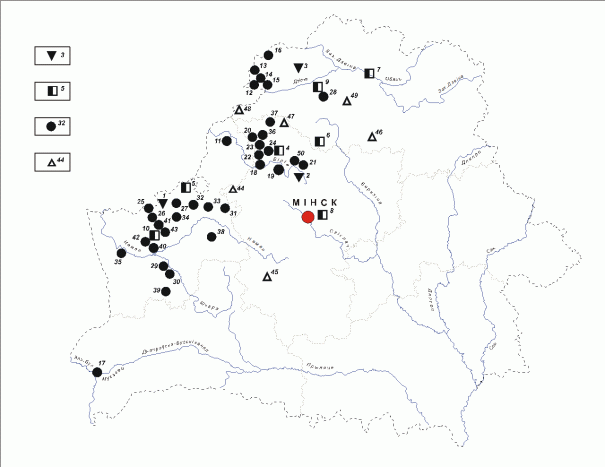
Ostatni megalityczny rytuał w Europie
Jest wiele dużych, odizolowanych kamieni, które zaśmiecają białoruską wieś. Wiele z tych kamieni było lub nadal jest czczonych jako obiekty kultowe lub święte kamienie. Ponad 500 z tych kultowych kamieni zostało opisanych przez ludzi.
Mapa lokalizacji kultowych głazów z dziurami stworzonymi przez człowieka na terenie Białorusi, zaczerpnięta z tej strony „Культовые валуны с кукотворными углублениями”.
Legend:
1 – flat stones with cup-shaped depressions;
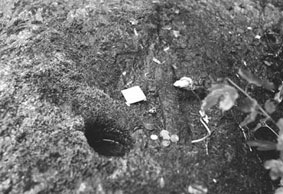
2 – cylindrical stones with cup-shaped depressions;
2 – kamienie cylindryczne z zagłębieniami w kształcie misek;
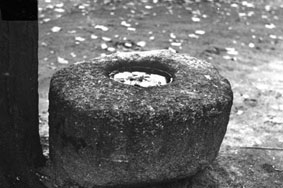
3 – stones with holes (round holes, cup marks) with a depth of 0.5 to 7 cm and a diameter of 3 to 7.5 cm;
3 – kamienie z otworami (okrągłe otwory, znaczniki kubkowe) o głębokości od 0,5 do 7 cm i średnicy od 3 do 7,5 cm;
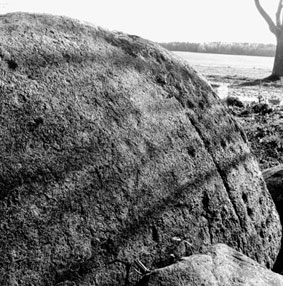
4 – stones with pits of irregular shape from 5 to 15 cm and dia. from 7.5 to 15 cm.
4 – kamienie z jamami o nieregularnym kształcie od 5 do 15 cm i średnicy. od 7,5 do 15 cm.
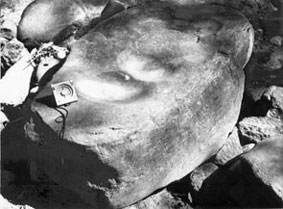
Some of theses stones were dated to Neolithic and Bronze age.
The above pictures were taken from this page of the „Культовые валуны с рукотворными углублениями” (Cultic stones with man made depressions).
Niektóre z tych kamieni datowane były na epokę neolitu i brązu.
Powyższe zdjęcia pochodzą z tej strony „Культовые валуны с рукотворными углублениями” (Cultic stones with man made depressions).
The most interesting among these hollowed stones is this stone from near the village of Kremenets in Lugoisk region in Belorusia, which has been dated to bronze age. It is known localy as Dabog’s (Daždbog’s) stone.
Najciekawszym z tych wydrążonych kamieni jest kamień pochodzący z okolic miejscowości Krzemieńce w regionie Lugoisk na Białorusi, datowany na okres brązu. Jest znany lokalnie jako kamień Daboga (Daždbog).
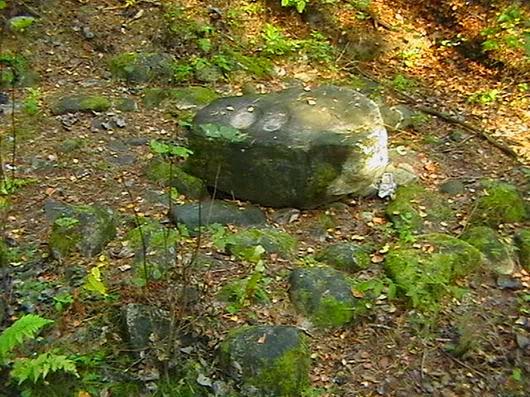

In Belorusia it was once believed that Dabog (Daždbog) lived in a castle somewhere far away in the east. Every morning he would drive out through the gates of his castle in his chariot and would drive accross the sky towards the west. His servants washed his face with rain. This is why his name is Daždbog, god of rain, dažd. This Belorussian belief explicitly identifies Dabog as the sun god as well as the rain god.
The same link between Thunder god (Perun) and Sun god (Svetovid), is also represented by the character of Ilija the Thunderer, the Thundering Sun god…Which shows that Dabog and Ilija the Thunderer are one and the same god.
Na Białorusi uważano kiedyś, że Dabog (Daždbog) mieszkał w zamku gdzieś daleko na wschodzie. Każdego ranka wyjeżdżał przez bramę zamku w swoim rydwanie i jechał po niebie na zachód. Jego słudzy obmywali mu twarz deszczem. To dlatego nazywa się Daždbog, bóg deszczu, dažd. Ta białoruska wiara wyraźnie identyfikuje Daboga jako boga słońca, a także boga deszczu.
Ten sam związek pomiędzy bogiem gromu (Perun) i bogiem Słońca (Svetovid), jest również reprezentowany przez postać Iliji Gromowładnego, Piorunowego boga solarnego… Co pokazuje, że Dabog i Ilija Gromowładny są jednym i tym samym bogiem.
Now here is something very very very (I don’t think there are enough verys I could put here) interesting about this Dabog stone which makes it probably one of the most important stones in the world.
Teraz jest coś bardzo bardzo interesującego (nie sądzę, żeby to co napisałem do tej pory nie było interesujące) o tym kamieniu Daboga, co sprawia, że jest to prawdopodobnie jeden z najważniejszych kamieni na świecie.
Według tych samych miejscowych starców, wieśniacy również zwracali się do kamienia o pomoc w okresach suszy, kiedy deszcz nie padał przez długi czas. Następnie wykonywano specjalną ceremonię z udziałem kamienia Daboga. Ceremonia była prowadzona przez jedną z najstarszych babć z okolicznych wsi. Przechodziła ona przez wioskę i zbierała ze sobą dziewięć wdów. Brały one ze sobą drewniane kołki pocięte na wysokość człowieka. Kobiety podchodziły do kamienia, podnosiły go za pomocą tych kołków jako żerczynie i intonowały specjalną modlitwę do kamienia z prośbą o opady deszczu.

Ostatni taki deszczowy rytuał na kamieniu został wykonany podczas suchego lata 1985 roku, a miejscowi mówią, że deszcz przyszedł po trzech dniach. Tutaj możesz zobaczyć wideo z całej ceremonii.
Now this is absolutely incredible in so many ways.
Teraz będzie coś absolutnie niesamowitego i to na wiele sposobów.
First the stone is clearly identified as the seat of Dabog, as Dabog personified. This can be seen from the fact that people prayed to the stone as if it was Dabog himself.
Po pierwsze kamień jest wyraźnie identyfikowany jako siedziba Daboga, jak uosobienie Daboga. Widać to z faktu, że ludzie modlili się do kamienia tak, jakby to był sam Dabog.
Second, the raising of the stone was part of the prayer ceremony. Is it possible that this is a remnant of the ancient megalithic raising of the stone ceremonies which left us all these thousands of standing stones all over Europe? Did ancient Europeans raise all the standing stones as part of the praying ceremony dedicated to the the Sky god? I already suggested that this was a possibility in my post entitled „Grandmother’s cudgels (clubs)” which talked about Orion, „The father of gods” and the original „Thundering giant” who during the Bronze Age caused climatic chaos with his stone clubs (meteorites) which he hurled from the sky. In Serbian „Thunder giant” is „Grom div”. I already wrote in several posts that I believe that „Grom div” was the original name of the Bronze Age sky god whose name came to us as „Hromi daba” the main epithet of Dabog, Serbian and Slavic sky god and as „Crom dubh”, the name of the Irish sky god…Now during Bronze Age the prayer ritual dedicated to the Sky god, Grom div, was probably performed during the extreme climatic events which threatened the survival of the people. During the praying ritual a new stone was hewn in the likeness of the Orion’s stone club (meteorite) and was raised and left standing pointing at the sky. This was eventually replaced with the pretend raising of the single stone which represented the Sky god Dabog, Hromi daba…So this stone raising ceremony preserved in Belorussia could be the last remnant of the Bronze Age megalithic sky worshiping religion…
Third, considering that the stone is equated with Dabog, the raising of the stone was in effect the raising of Dabog. Do you know of of any other raising of the god ceremony? (This is a trick question :)). Dabog is in Serbia also known as Djed, meaning Grandfather, The ancestor. He is seen as the ancestor of all the Serbs. This is why Dabog is in Serbian mythology seen as the sun god, Giving god (rain and grain god) and the good of the dead. So raising of the Dabog stone is effectively raising of the Djed…
And in Egyptian religion „djed” was a pillar associated with Osiris. The djed pillar was an important part of the ceremony called ‚raising the djed’. The act of raising the djed has been explained as representing Osiris’s triumph over Set. The djed hieroglyph was a pillar-like symbol that represented stability. It was also sometimes used to represent Osiris himself. Osiris the sun god, the god of grain and the god of the dead. Osiris whose soul was Sahu, constellation Orion, the Thundering Giant of the Bronze Age…
Po trzecie, biorąc pod uwagę, że kamień jest utożsamiany z Dabogiem, podniesienie kamienia było w efekcie podniesieniem Daboga. Czy znasz jakieś inne podniesienie ceremonii boga? (To podchwytliwe pytanie :)). Dabog jest w Serbii zwany również Djed, co znaczy Dziadek, Przodek. Jest postrzegany jako przodek wszystkich Serbów. To dlatego Dabog jest w serbskiej mitologii postrzegany jako bóg słońca, Bóg Dawca (bóg deszczu i bóg zboża) i nazywany Dobrem Zmarłych. Zatem podniesienie kamienia Daboga jest też w efekcie podniesieniem Dziadów …
A w egipskiej religii „djed” (dziad) był filarem związanym z Ozyrysem. Filar djed (dziad) był ważną częścią ceremonii zwanej „podniesieniem djeda (dziada)”. Akt podniesienia djeda (dziada) został wyjaśniony jako imitujący triumf Ozyrysa nad Setem. Djed (dziadowy) hieroglif był symbolem przypominającym słup, który reprezentował stabilność. Czasami był również używany do reprezentowania samego Ozyrysa. Ozyrys, bóg słońca, bóg zboża i bóg zmarłych. Ozyrys, którego duszą był Sahu, konstelacja Oriona, Piorunowy Gigant z epoki brązu …
Czy to nie jest interesujące?
So, very interesting isn’t it?
źródło: http://oldeuropeanculture.blogspot.com/2018/03/the-last-megalithic-ritual-in-europe.html
Tak pisał Boris Cok:
